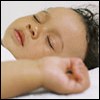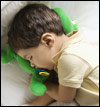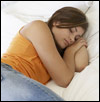Current Features
Sleep and Sleep Disorders

How you feel and perform during the day is related to how much sleep you get the night before. If sleepiness interferes with your daily activities, more sleep each night will improve the quality of your waking hours. Yet many adults report experiencing a sleeping problem one or more nights a week.
Insufficient sleep is associated with a number of chronic diseases and conditions—such as diabetes, cardiovascular disease, obesity, and depression—which threaten our nation’s health. Not getting enough sleep is associated with the onset of these diseases and also may complicate their management and outcome.
Sufficient sleep is increasingly being recognized as an essential aspect of chronic disease prevention and health promotion. How much sleep is enough? Sleep needs vary from person to person and change as people age. Consider these sleep guidelines for different age groups (and note that the total hours recommended for children 5 years of age and younger include naps).
How much sleep do you need each night?*

Infants
• Birth�months need 10.5� hours
• 2� months need 14� hours

Toddlers/Children
• 12–18 months need 13–15 hours
• 18 months–3 years need 12–14 hours
• 3–5 years old need 11–13 hours
• 5–12 years old need 9–11 hours

Adolescents need at least 8.5–9.5 hours

Adults typically need 7–9 hours
*Data from the National Sleep Foundation
Sleep Hygiene
The promotion of regular sleep is known as sleep hygiene. Here are some simple sleep hygiene tips:
• Go to bed at the same time each night, and rise at the same time each morning.
• Sleep in a quiet, dark, and relaxing environment, which is neither too hot nor too cold.
• Make your bed comfortable and use it only for sleeping and not for other activities, such as reading, watching TV, or listening to music.
• Remove all TVs, computers, and other "gadgets" from the bedroom.
• Avoid physical activity within a few hours of bedtime.
• Avoid large meals before bedtime.
You can promote sleep hygiene by sending a sleep Health-e-Card.
Sleep Disorders
“… Sufficient sleep is not a luxury—it is a necessity—and should be thought of as a vital sign of good health.”
Wayne H. Giles, MD, MS, Director,
Division of Adult and Community Health,
National Center for Chronic Disease Prevention and Health Promotion.
Sleep-related difficulties – typically called sleep disorders – affect many people. Major sleep disorders include:
• Insomnia – an inability to fall or stay asleep that can result in functional impairment throughout the day.
• Narcolepsy – excessive daytime sleepiness combined with sudden muscle weakness; episodes of narcolepsy are sometimes called "sleep attacks" and may occur in unusual circumstances.
• Restless Legs Syndrome (RLS) – an unpleasant "creeping" sensation associated with aches and pains throughout the legs that can make it difficult to fall asleep.
• Sleep Apnea – interrupted sleep caused by periodic gasping or "snorting" noises or momentarily suspension of breathing.
If you or someone you know is experiencing a sleep disorder, it may be important to receive an evaluation by a healthcare provider.
For More Information
- Sleep and Sleep Disorders: A Public Health Challenge
- Perceived Insufficient Rest or Sleep -- Four States, 2006, MMWR, 29 Feb 2008.
- No Rest for the Weary
 (3 minutes 3 seconds)
(3 minutes 3 seconds)
- American Sleep Apnea Association
- How Sleep Works, National Sleep Foundation
- Restless Leg Syndrome Foundation
- Sleep Research Society
Page last updated: May 1, 2008
Content source: Division of Adult and Community Health
Content owner: National Center for Health Marketing
URL for this page: www.cdc.gov/Features/Sleep

